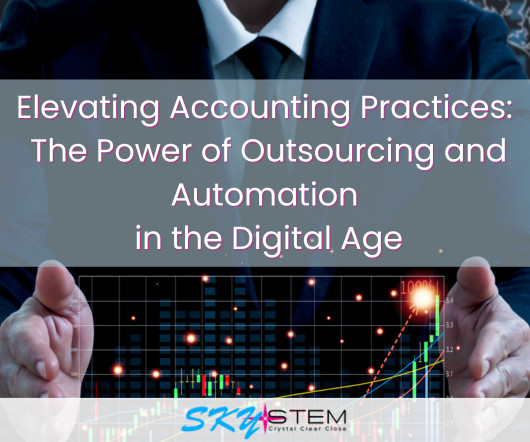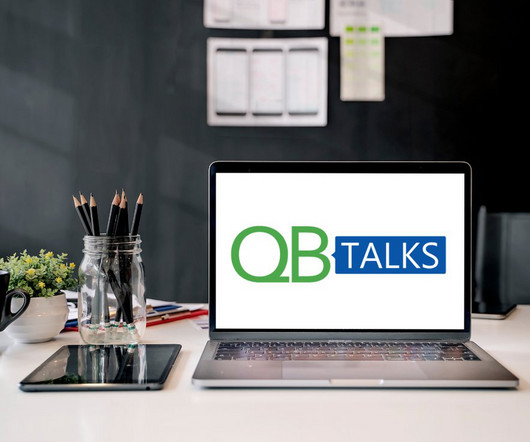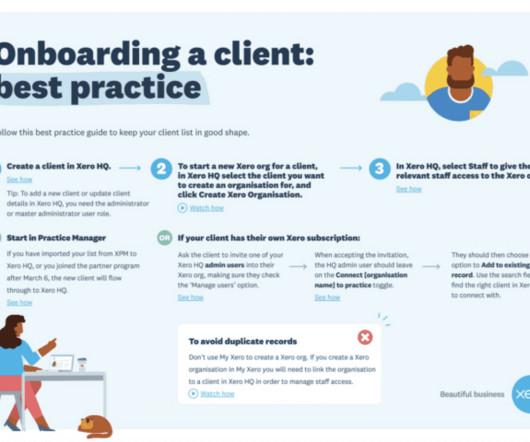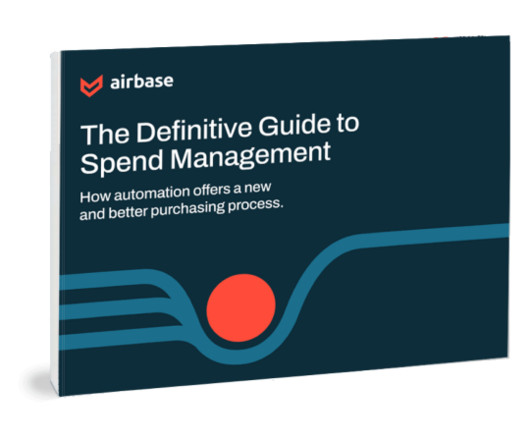Small Businesses See Gains from Outsourcing HR
Insightful Accountant
JUNE 18, 2023
In this ADP Workforce News Minute, ADP's Kristen Appleman explains why retaining and developing top talent are more important than ever. Check out the video here.

Insightful Accountant
JUNE 18, 2023
In this ADP Workforce News Minute, ADP's Kristen Appleman explains why retaining and developing top talent are more important than ever. Check out the video here.

Accounting Tools
JUNE 18, 2023
Related Courses The Balance Sheet The Income Statement The Interpretation of Financial Statements The Statement of Cash Flows What is Relevant Information? Relevant information is data that can be applied to solve a problem. This is a particular issue when determining the format and content of an entity's financial statements , since the proper layout and level of detail of information can adjust the opinions of users regarding the future direction of a business.
This site is protected by reCAPTCHA and the Google Privacy Policy and Terms of Service apply.

Insightful Accountant
JUNE 18, 2023
If you're still using traditional methods to onboard your workflow process, Liz Scott has some tools that will help you save time.

Accounting Tools
JUNE 18, 2023
Related Courses Business Ratios Guidebook The Interpretation of Financial Statements What is Return on Sales? The return on sales is a ratio used to derive the proportion of profits generated from sales. The concept is useful for determining the ability of management to efficiently generate a profit from a given level of sales. An increasing return indicates an improvement in operating efficiency , while a recurring decline is a strong indicator of impending financial distress.

Speaker: Nancy Wu, Head of Sales and Customer Success at SkyStem
Join us for an enlightening webinar as we delve into the transformative realm of modern accounting practices. In today's digital age, the convergence of outsourcing and automation has revolutionized how businesses manage their financial operations. In this webinar we will explore the synergistic potential of these two strategies to streamline processes, enhance accuracy, save cost and drive strategic decision-making.

Insightful Accountant
JUNE 18, 2023
Last week's QB Talks had to be rescheduled. Tune in this Wednesday, June 21st at 2 PM (EST) for the latest and greatest information about QuickBooks Online with host Liz Scott.

Accounting Tools
JUNE 18, 2023
Related Courses Optimal Accounting for Payables Payables Management Traditional Payables Matching The classic approach to managing the accounts payable paper flow is to match three documents against each other, as follows: Compare the supplier's invoice to the company's authorizing purchase order to ensure that the pricing terms are correct Compare the purchase order to the receiving documents to ensure that the quantities received match the authorized amount This comparison process is slow, so
Financial Ops World brings together the best financial operations content from the widest variety of thought leaders.

Accounting Tools
JUNE 18, 2023
Related Courses Business Ratios Guidebook Financial Analysis The Interpretation of Financial Statements What is Net Operating Profit After Tax? NOPAT is an acronym that stands for Net Operating Profit After Tax. The measurement is a good way to understand the underlying profitability of a business by stripping away the effects of financing and tax effects related to financing, since its primary focus is on earnings generated by operations.

Xero
JUNE 18, 2023
We’ve made some great progress towards creating a single source of truth for your client data. It’s all part of our work to connect our practice tools, so that in the future, as you manage your clients’ tax obligations in Xero, the data flows seamlessly into our practice management tools. This will help you work more efficiently, collaborate with your clients more effectively, and manage everything for your practice within Xero.

Accounting Tools
JUNE 18, 2023
Related Courses Budgeting Financial Analysis Fixed Asset Accounting Depreciation does not directly impact the amount of cash flow generated by a business, but it is tax-deductible , and so will reduce the cash outflows related to income taxes. Depreciation is considered a non-cash expense , since it is simply an ongoing charge to the carrying amount of a fixed asset , designed to reduce the recorded cost of the asset over its useful life.

Billing Platform
JUNE 18, 2023
Showing no signs of slowing, the subscription economy is booming. A UBS report revealed that subscription business models could grow from a $650 billion market to a $1.5 trillion market by 2025. While subscription billing is a better fit for some business models and verticals than others, we are seeing an increasing number of industries transition from traditional sales to a recurring revenue business model.

Speaker: Robbie Bhathal, Founder & CEO, and Matthew Acalin, Head of Credit Intelligence
In today's volatile financial environment, how confident are you in your company’s financial forecasting? To get the most accurate cash predictions that will lead to long-term financial survival, real-time data is critical. Innovative cash management strategies can lead to better credit opportunities, more sustainable growth, and long-term financial prosperity.

Accounting Tools
JUNE 18, 2023
Related Courses Activity-Based Costing Cost Accounting Fundamentals What are Indirect Costs? Indirect costs are costs used by multiple activities, and which cannot therefore be assigned to specific cost objects. Examples of cost objects are products, services, geographical regions, distribution channels , and customers. Instead, indirect costs are needed to operate the business as a whole.

Xero
JUNE 18, 2023
We’ve made some great progress towards creating a single source of truth for your client data across Xero Practice Manager (XPM), Xero HQ and Xero Tax. This is an important part of our work to connect our practice tools, so you can work more efficiently, collaborate with your clients more effectively and get the most out of the entire Xero platform.

Accounting Tools
JUNE 18, 2023
Related Courses Accounting for Inventory How to Audit Inventory There are a number of inventory journal entries that can be used to document inventory transactions. In a modern, computerized inventory tracking system, the system generates most of these transactions for you, so the precise nature of the journal entries is not necessarily visible. Nonetheless, you may find a need for some of the following entries from time to time, to be created as manual journal entries in the accounting system.

Accounting Tools
JUNE 18, 2023
Related Courses Divestitures and Spin-Offs Mergers & Acquisitions Public Company Accounting and Finance What is a Reverse Acquisition? A reverse acquisition occurs when there is a business combination in which the entity issuing securities is designated as the acquiree for accounting purposes. This arrangement usually takes place so that a privately-held company can be acquired by a smaller shell company that is publicly-held , resulting in a combined entity that is publicly-held.

Advertisement
All accounting teams know what it is like to dread the inevitable month-end scaries. If there was a way to feel less burdened and maybe even a little enthusiastic to work on your month-end close and reconciliation process, would you do it? No, don't answer that, of course you would! Automate your month-end close process by up to 40% with SkyStem's ART and see how much more alive you feel!

Accounting Tools
JUNE 18, 2023
Related Courses Business Insurance Fundamentals Disaster Recovery Planning Enterprise Risk Management What is Risk? Risk is the probability of a negative outcome. It is a major consideration when deciding whether to make an investment. A high level of risk is associated with a high standard deviation for the expected return associated with an investment, while a low level of risk is associated with a low standard deviation for expected returns.

Accounting Tools
JUNE 18, 2023
Related Courses How to Audit Payroll Optimal Accounting for Payroll Payroll Management What is a Bimonthly Payroll? The term "bimonthly" means that something occurs once every two months. Therefore, a bimonthly payroll means paying employees once every two months. Since this is not only illegal in many locations, but also an oppressively long pay period, a bimonthly payroll is not recommended!

Accounting Tools
JUNE 18, 2023
Related Courses Business Ratios Guidebook Credit and Collection Guidebook The Interpretation of Financial Statements What is the Accounts Receivable Collection Period? The accounts receivable collection period compares the outstanding receivables of a business to its total sales. This comparison is used to evaluate how long customers are taking to pay the seller.

Accounting Tools
JUNE 18, 2023
Related Courses Accounting for Leases What is a Right-of-Use Asset? The right-of-use asset is a lessee's right to use an asset over the life of a lease. The asset is calculated as the initial amount of the lease liability , plus any lease payments made to the lessor before the lease commencement date, plus any initial direct costs incurred, minus any lease incentives received.

Advertisement
The status quo for AP in small and mid-market companies is broken. It consists of messy tech stacks of siloed solutions that give rise to manual work, a lack of control, wasted spend, and unnecessary risks. The benefits of shifting to spend management are tangible, measurable, and are felt across the whole organization. Spend management is a different way of thinking and an innovation whose time has come.

Accounting Tools
JUNE 18, 2023
Related Courses Business Ratios Guidebook Cost Management Guidebook Financial Analysis The Interpretation of Financial Statements What is the Breakeven Point? The breakeven point is the sales volume at which a business earns exactly no money. At this point, a business is able to cover its fixed expenses. The breakeven point is useful for determining the amount of remaining capacity after the breakeven point is reached, which tells you the maximum amount of profit that can be generated.

Accounting Tools
JUNE 18, 2023
Related Courses Accounting for Retirement Benefits What is a Minimum Pension Liability? A minimum pension liability arises when the accumulated benefit obligation for a pension plan is greater than the fair value of the plan's assets. This amount is an unfunded liability that the organization sponsoring the plan will eventually need to fund, so that the expected payouts to pensioners can be made.

Accounting Tools
JUNE 18, 2023
Related Courses Business Ratios Guidebook Effective Collections The Interpretation of Financial Statements What is Accounts Receivable Days? Accounts receivable days is the number of days that a customer invoice is outstanding before it is collected. The point of the measurement is to determine the effectiveness of a company's credit and collection efforts in allowing credit to reputable customers, as well as its ability to collect cash from them in a timely manner.
Let's personalize your content